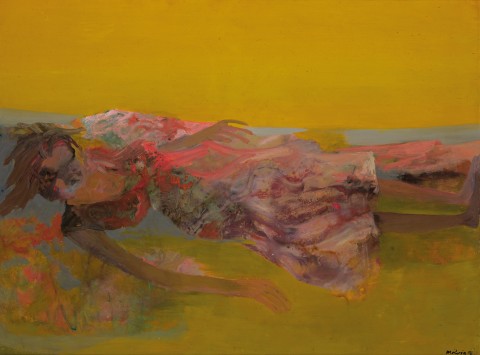SLEEPING LUBRA, 1958
JON MOLVIG
oil on composition board
76.5 x 102.5 cm
signed and dated lower right: Molvig 58
Estate of A. Waldron
The Johnstone Collection, Brisbane
Christie’s, Brisbane, 5 June 1994, lot 14
Philip Bacon Galleries, Brisbane
Private collection, Brisbane, acquired from the above
Jon Molvig, The Johnstone Gallery, Brisbane, 28 April – 15 May 1959, cat. 4
Jon Molvig: Maverick, Queensland Art Gallery, Brisbane, 14 September 2019 – 2 February 2022
Churcher, B., Molvig - the lost Antipodean, Penguin Books, Melbourne, 1984, cat. 207, pp. 74, 77 (illus.)
Hawker, M., Heiser, B., Helmrich, M., and Littley, S., Jon Molvig: Maverick, Queensland Art Gallery, Brisbane, 2019, pp. 16, 108 (illus.), 178
‘Because he has been so difficult to categorize, Molvig has often been overlooked by historians and curators, and there are few artists about whom such confusion has reigned. Yet, at the full stretch of his talent, he has produced images so powerful and urgent that they have that quality of all good art: they remain in the mind in all their original clarity.’1
From a working-class family in Newcastle, Molvig experienced an unsettled childhood and then served in New Guinea and the Philippines during World War II. He studied art in Sydney before travelling to Europe where he encountered the German and Norwegian expressionists whom he believed were more influential on his practice than his Australian contemporaries… In 1955, Molvig would settle in Brisbane for the better part of his adult life. At the time, the only formal courses for emerging artists involved particularly rigid and rigorous technical training, and little consideration of style. From a studio in Kangaroo Point, which was run by John Rigby (who had inherited it from Margaret Cilento), Molvig offered an alternative. At the same time as teaching a growing cohort of rapt students, Molvig developed his own distinctive style, one that Betty Churcher called ‘a lucid and accomplished expressionism.’2
An intensely complicated artist and individual, Molvig was a relentless innovator and his experimentation could be brilliantly iconoclastic. In Robert Hughes’ The Art of Australia, the young critic singled out Molvig: ‘His art exalts the vitality of the first moment of perception,’ Hughes wrote, noting that while the artist’s style was mutable, his exploration of new techniques and approaches was nonetheless strategic.3
A formidable presence on the Brisbane art scene during the late 1950s and 1960s, indeed Molvig’s work was provocative, and as inspiring to his students as it was insistent and uncompromising… Churcher divided this part of his career into two periods: tumultuous and complex pictures from the late 1950s and early 1960s – punctuated by a series of landscapes that built on his visit to Central Australia in 1958 – and his ‘Eden industrial’ pictures, inspired by Newcastle.4 Discussing Sleeping Lubra, 1958 and another closely related work from this period titled Untitled Portrait: Sleeping Aboriginal Woman and Child, 1958, Churcher notes that ‘…the allegorical quotient ensured that Molvig was able to operate on a level of meaning that went beyond the image. In both paintings an Aboriginal woman in a pink dress lies in a parched landscape under a hot sky. The anthropomorphic curves and furrows that had animated the surface of Ayer’s Rock in Centralian Landscape have hereby been given specific human form, and like the legendary women from the Aboriginal Dreaming, they seem at the very point of metamorphosis, when their bodies will be converted forever into the features of the landscape. They could also be a metaphor for the desert: the arid land that stretches out like a baited trap, set with opalescent colour to seduce the eye and lure the foolhardy or unwary to their death.’5
Significantly, Sleeping Lubra, 1958 was recently included in the major retrospective exhibition at the Queensland Art Gallery I Gallery of Modern Art, Brisbane from 2019 – 20. In the accompanying publication, Jon Molvig: Maverick, the first significant monograph on the artist since 1984, curator Michael Hawker elaborates, ‘…In works such as Sleeping Lubra, 1958, the figures are not just part of the landscape, they embody it. In Sleeping Lubra, the woman’s languid arm in the foreground has the contours of a dry creek bed while her torso and hips echo worn ridges and deep valleys. Molvig enhances this idea of embodiment in his use of colour – the ochre-like, chalky pinks, oranges, greys and charcoals immediately suggest the distinctive hues of the outback.’6
1. Betty Churcher cited in Jon Molvig: Maverick, Queensland Art Gallery I Gallery of Modern Art, Brisbane, 2019, p. 94
2. Churcher, B., Molvig -The Lost Antipodean, Penguin Books, 1984, p. 47
3. Hughes, R., The Art of Australia, Penguin Australia, Melbourne, 1984, p.43, cited in Saines, C., ‘Foreword’ in Jon Molvig: Maverick, op. cit. ibid., p. 9
4. Saines, ibid.
5. Churcher, 1984, op. cit., p. 73
6. Hawker, M., ‘John Molvig: Restlessness of Vision’, in John Molvig: Maverick, op. cit., p. 16
